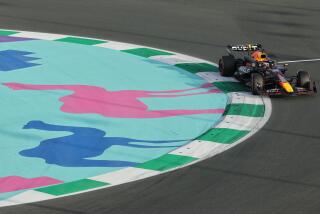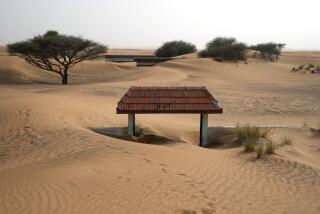MICHAEL McKINNON: DIRECTOR OF ARABIA
- Share via
When one think of Arabia, one visualizes deserts, camels and nomads. But the vast country is much more than sand and dust. The mysteries and contrasts of the region, which was born out of Africa nearly 35 million years ago, are explored in the three-part series, “Arabia: Sand, Sea & Sky,” which premiered last week on the Discovery Channel.
Episode II-”The Red Sea Rift”-- airs Tuesday at 5 p.m.; the conclusion-”Eye of the Camel”--airs May 29 at 5 p.m.
Michael McKinnon, the Australian-born producer and director of “Arabia: Sand, Sea & Sky,” talked about the making of the documentary series with Susan King.
How did the series come about?
I did a series a few years ago called “Treasures of the Gulf,” which was shown on “Nature.” That was six films on the natural history of the Gulf area, the sea between the Arabian countries and Iran. In the course of doing that research and making those films, I was constantly exposed to the fact that all the wildlife was on the other side of Arabia. I then started to do some research and found out there were a large population of baboons in the mountains and yellow cobras and God knows what. There were all sorts of things that no one had seen a single photograph of.
I traveled a lot and talked to a lot of scientists. Just at the point I was getting momentum and getting financing together, the Saudi Arabians established something called the National Commission for Wildlife and Conservation. They themselves pulled together all sorts of studies that different people had been doing. All of a sudden, there was this great windfall of having access to the work of 50 or 100 scientists who were doing great detailed studies. That’s what helped make the series come alive.
How long did it take to film the series?
It took us two and a half years of filming and editing and a year and a bit for preparations, travel, seeking out locations and tracking down the stories.
The series features remarkable footage of animals, birds and marine life. It must have been difficult and time-consuming to get the footage.
One of the characteristics of this kind of filming is that if you move into a territory with land crews and tripods and you set up a hide, nothing comes near because it’s too big and too bulky and too strange. Because we didn’t shoot at anything and were being reasonably quiet, most of the birds tended to trust us after we were there for about four days. So all of our bird material was shot without hides, simply because we were able to settle into the environment a bit.
If you go down into the marine environment, you take a little bag of fish and feed the fish out of plastic bags for a couple of days, and they tend to relax. You can get very close. You can take your tripods down. It takes a few days for them to trust you, and that takes patience and being very still and keeping a fairly low profile.
Much of our filming was done on the run. We were camping a lot and out on remote places. When we filmed the Bedouins, because we were traveling 20 miles a day with the camels, we were not able to pitch camps. We slept under the stars, which was wonderful. We basically lived their life and moved with them.
Before you became a filmmaker you were a painter. Does your artistic background give you a different slant on making documentaries?
I suppose if you have been a painter for 10 years you trust your eye. You trust the image. If you’ve got a good image, it will carry most of the burden of the story.
So when it comes to choosing cameramen with wonderful eyes, there’s a lot of agreement between them and myself as to what makes a good image. We are the kind of people who would like to make films without having to use words. We would like the final cut of the film to tell the story. We really have gone for the image. We tried to build sequences which are very powerful in their image rather than supportive of words. We haven’t tried to use inadequate images to support interesting verbal theory.
What is the biggest misconception people have about Arabia?
Because of the age of oil, journalistic focus has been on eastern Arabia, where you have got the desert and the Gulf. Historically, the mountain area of Arabia has always been the most populated region. The nomadic region is a much smaller group of people. But on the other hand, it’s more romantic and more attractive to the Western imagination.
What was most difficult about shooting the series?
The most difficult thing was judging the seasons right. So much of the life in the desert is nomadic.
If birds decide there hasn’t been enough rain for the growth to bring on insects, they will simply keep moving. What we tried to do with our scientific advice was to say, “OK. We are going to film the desert larks in an area of the northern desert.”
We arrived there on the basis of the seasons for the past three years, but we were a month early. Spring only lasts for a couple of weeks, so we had to pick up our bags and go away and work somewhere else for three weeks.
When we went back to that place, we hit it on peak. The place was just popping with life, and a couple of weeks later, it was all over. The story of the wildlife has so much to do with hitting it right.
Because Arabia is between Asia and Africa, there are hundreds and hundreds of millions of birds flying across it every year. But it all happens within a couple of weeks. What we tried to do in the couple of years was to lay out a game plan that would take advantage of each of these events, so we could build the stories. That’s why it took two years to film, because one was trying to take hold of this incident and that incident and then slowly build up the stories and make the film.
More to Read
The complete guide to home viewing
Get Screen Gab for everything about the TV shows and streaming movies everyone’s talking about.
You may occasionally receive promotional content from the Los Angeles Times.






